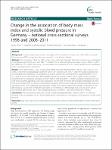Change in the association of body mass index and systolic blood pressure in Germany – national cross-sectional surveys 1998 and 2008–2011
Adler, Carolin
Rosario, Angelika Schaffrath
Diederichs, Claudia
Neuhauser, Hannelore
Background: A recent weakening and even decoupling of the association of body mass index (BMI) and systolic blood pressure (SBP) in population data was reported, i. a. for Western Europe. Methods: The association of BMI and SBP in recent cross-sectional population data from Germany was investigated in participants aged 18–79 years with BMI 17.5-40 kg/m 2 from national health examination surveys 1998 (n = 6,931) and 2008–2011 (n = 6,861) in Germany. The association was analyzed both in the overall samples and in participants without antihypertensive medication. Results: From 1998 to 2008–11, age- and sex-standardized mean SBP decreased from 129.0 (CI 128.2-129.7) to 124.1 (123.5-124.6) mmHg in all participants and from 126.0 (125.4-126.7) to 122.3 (121.7-122.8) mmHg among persons not on antihypertensive medication. The proportion of persons treated with antihypertensives augmented from 19.2 % (17.7-20.8) to 25.3 % (24.0-26.6). Mean BMI remained constant at around 27 kg/m 2 with a slight increase in obesity prevalence. BMI was positively associated with SBP both in 1998 and 2008–11, yet the association tended to level out with increasing BMI suggesting a non-linear association. The strength of the BMI-SBP-association decreased over time in all and untreated men. In women, the association weakened in the overall sample, but remained similarly strong in untreated women. The unadjusted linear regression models were used to estimate the increase in SBP within 5-unit BMI increases. E. g. for men in 1998, SBP was higher by 7.0 mmHg for a BMI increase from 20 to 25 kg/m 2 and by 3.6 mmHg for BMI 30 to 35 kg/m 2 . The corresponding values for 2008–11 were 3.8 mmHg and 1.7 mmHg. Conclusions: The cross-sectional association of BMI and SBP decreased between 1998 and 2008–11 in Germany, however it did not disappear and it is in part explained by improvements in the diagnosis and treatment of high blood pressure.
Dateien zu dieser Publikation
Keine Lizenzangabe

